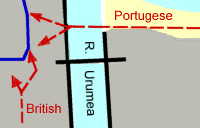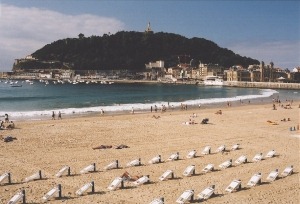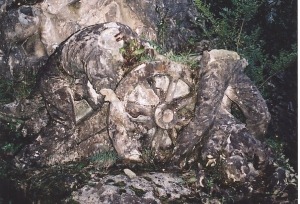
After repulsing Soult's counter-offensive through the Pyrenees at Sorauren, Wellington returned to his plan of capturing the well-fortified town and port of San Sebastián before making any attempt to cross the border into France. Overlooked to the north by Monte Urgull and the Castle of La Mota, San Sebastián stood across a narrow isthmus with its approach from the south protected by a formidably-strong fortification known as the Hornwork. In 1813, it was possible at low tide to reach the eastern face of the town's walls by foot, and it was from this direction that an unsuccessful assault had been made on 25th July. Over the following month, the town's defences had been reinforced by the construction of a thick, high stone wall behind the repaired breach. Despite everything, it was decided that the second assault would be made against the same point, albeit only after better artillery preparation. The bombardment began at 9am on 26th August, the main work being done by 30 guns in two batteries facing the site of the old breach. By the end of the 30th, a breach had been made which extended almost 90 metres north from the southeast corner of the town's walls; further along the wall, a second, much smaller breach had also been made. The artillery bombardment reopened at dawn on the 31st. By a stroke of good fortune, one shot disabled a mine which had been laid under the main breach. At 10.55am, one hour ahead of low tide, the bombardment lifted and the assault against the main breach began, led by the 1/4th, 2/47th and 2/59th of Robinson's Brigade (5th Division) strengthened by 750 volunteers from the 1st, 4th and Light Divisions. Leading a 'forlorn hope' of 40 men from the 1/4th, Lt. Francis Macguire was shot dead at the foot of the breach. Wave after wave clambered past to the top of the steep breach only to find the way forward blocked by a sheer drop of at least 6 metres. Swept by terrific frontal and flanking fire, each wave was blown back. The survivors clung to the rubble at the foot of the breach, desperately seeking cover. At 11.35am, 800 men from Bradford's Portuguese Brigade were sent in two columns against the smaller breach. The enemy guns were able to fire just two salvos in the impressively short time that it took the Portuguese to cross 650 metres of tidal flats, and to wade thigh-deep for 180 metres across the river estuary. While one column veered away towards the main breach, the other fought to gain a foothold in the smaller breach. The impasse was broken by the decision of the Allied commander, Sir Thomas Graham, to order his artillery batteries to open fire against the high curtain which abutted the southern end of the main breach. Over a 20-minute period from 12.15pm, shells flew over the heads of the Allied infantry crouched beneath the breach to inflict terrible carnage amongst the French troops manning the curtain. As the barrage lifted at 12.35pm, the British infantry surged forwards once more, this time gaining a decisive bridgehead on the high curtain. As resistance along the curtain fell away - fuelled by the detonation of an ammunition store - troops of the Light Division forced another opening into the town at the northern end of the breach. The Portuguese too were breaking through at the smaller breach. By around 2.15pm, the town was in Allied hands, the French commander, General Emanuel Rey, having led the survivors from the garrison into the temporary security of the castle.
Inside the town, fires which had been started by the artillery bombardment were swept from street to street by high winds, while the horrors inflicted on the inhabitants by battle-crazed Allied troops are said by some to have exceeded those at Badajoz. Rey finally surrendered on 8th September, after the castle had been subjected to a 2 hour-long bombardment from 61 guns and mortars. French casualties during the siege amounted to some 1,400, while a further 1,300 were taken prisoner when the castle fell. The Allies lost 2,400 killed, wounded and missing during the assault. San Sebastián (Donostia) is a great place to visit and makes an excellent base for touring the Battles of the Pyrenees. There is, however, little evidence today of the events of 31st August 1813. The storming sparked off the worst fire in the town's history, leaving only one street left standing; the street - now named the 31 de Agosto - is filled each anniversary with silent townspeople carrying candles in commemoration of that dreadful day. The town was completely rebuilt after the fire, creating what is now known as the Parte Vieja (Old Quarter). The town walls were demolished in 1864, and land was reclaimed from the Urumea river. The location of the main breach is now marked only by La Bretxa (The Breach) market. The Cementerio de los Ingleses (English Cemetery) should be visited, though its once-fine monument to the memory of the British soldiers who died in the Peninsular and Carlist Wars appears to have been terribly vandalized. Walk along the harbour-front to the Aquarium. Climb the steps, then follow the path into the park on Monte Urgull. The cemetery is well-signposted from here. "A History of the Peninsular War, Volume VI" by Sir Charles Oman, published by Greenhill Books 1995, ISBN 1853672262. "Wellington in the Peninsula 1808-1814" by Jac Weller, published by Greenhill Books 1999, ISBN 1853673811. Map of the siege of San Sebastián courtesy of The Napoleon Series. © Andrew C Jackson 2004
|


